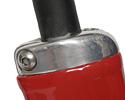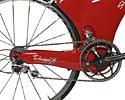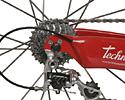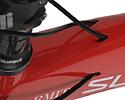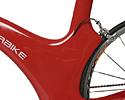
Recently on Cyclingnews.com |
On test: Technique Sports SuperbikeMarkOne frame, August 9, 2006
Cheating the wind and bucking convention
Steve Beletich finds it easy to go fast on the SuperbikeMarkOne frame, a piece of 1990s bicycle history reincarnated for the new millennium.
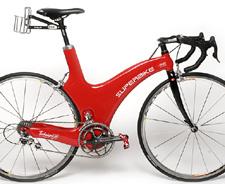
|
|
|
|
|
|
|
|
|
|
|
|
|
|
|
|
|
|
Back in the early 1990's, Australia's Royal Melbourne Institute of Technology and the Australian Institute of Sport collaborated to develop the "Superbike" track racing frame. From 1994 to 1996, the frame (in carbon fibre) was ridden to victories and medals in numerous track events at World Cup, World Championship and Olympic levels. Its riders include such Australian greats as Gary Neiwand, Kathy Watt, Brad McGee, Stuart O'Grady and Shane Kelly. Events included individual pursuits, team pursuits and time trials over distances of 1000m to 4000m.
After the UCI disallowed bike frames without the equivalent of tubes from their events, the Australian team stopped using the Superbike. However Australian company Technique Sports has continued to manufacture the frame, and the latest incarnation is the all-aluminium SuperbikeMarkOne.
I suspect the good people at Technique Sports threw on some Campagnolo running gear for our benefit, because ordinarily the Superbike is available with either Shimano Ultegra or Dura-Ace. Ours came equipped with Campagnolo Chorus, FSA K-Force cranks and Ksyrium Elite wheels. The frame itself is of course the un-missable centrepiece, especially when coated in Ferrari red as ours was. For the more timid, it also comes in yellow, blue, black, white and grey.
On the road, the Superbike certainly turned heads and started conversations. Fellow cyclists would pull alongside to discuss the bike, its origins and performance. All were fascinated with the pedigree, which commands a certain respect once informed she was the choice of such greats as McGee, O'Grady and Kelly. I must admit that I was pleasantly surprised by this, as I expected to be the subject of scorn from Sydney's fickle cycling community.
Performance wise, the one-piece aluminium frame was, not surprisingly, extraordinarily stiff. Power transmission off the mark was exceptional, and there was not a hint of flex or mushiness. One glance at the inches and inches of aluminium surrounding the bottom bracket, not to mention the massive chain stays, explained this phenomenon pretty quickly.
The price paid for this attribute was of course the efficiency of the frame in transmitting road vibration. Ripples and road imperfections came straight through to my arms and bum, and that hollow hunk of aluminium frame seemed to amplify them to an audible frequency. This also applied to freewheel noises and gear changing, which were more than noticeable. Not that this was a bad thing, I like to hear the freewheel and know when I have shifted up a gear on the rear cassette.
Top end speed seemed exceptional, which may be a function of the frame's aerodynamics and efficiency, or possibly just the placebo effect. I'm not sure which, but the Superbike did seem to zing along at high speed, and accelerated from fast to very fast quite rapidly. Also surprising was the handling, which was much more surefooted than other aggressive time trial frames I have ridden.
If the looks, pedigree and speed appeal, the inevitable question is then, "Is it race legal?" In some jurisdictions, the answer seems to be "yes". USA Cycling, according to its rulebook applies UCI bike rules only in events "that select 17-18, U23 and elite riders for international competition or national teams." That would seem to open the door to the Superbike for everything else. Similarly, the UK's governing body for time trials, the RTTC, makes no mention of UCI-style frame construction regulations in its rules. However, in the Superbike's homeland, Cycling Australia simply adopts the UCI regulations for all races, rendering the Superbike velo non grata at races Down Under. (No doubt someone will let us know if we've misread any of the relevent rules.)
In conclusion, this is a frame for those who value aerodynamics and pedaling efficiency, and who do not have to adhere to UCI technical regulations. Triathletes, time trialists and recreational cyclists come to mind. It's fast, stiff and lighter than one might expect. Road vibration is poor, but if you are not bothered by this, and have a healthy respect for track cycling folk lore, then the Superbike is worth a look. You'll definitely stand out from the crowd.
Photography
For a thumbnail gallery of these images, click here
Images by Paul Henderson-Kelly/Cyclingnews
- Technique Sports SuperbikeMarkOne is an aluminium version of the famous Australian Superbike of the 90s.
- The special seatpost clamp adapts the aero seat tube for a regular round seat post.
- FSA cranks and Campagnolo transmission and an odd-looking but elegant rear frame.
- The front derailleur sits on a bolt-on fitting that's recessed into the frame to provide enough movement for the gears.
- It's just a stay - a single member either side supports the rear wheel
- Replaceable dropout - because breaking a fixed one would be a very expensive disaster.
- Swoopy lines - the frame supports the head tube with an elegantly curved front section.
- Born in academe - The Royal Melbourne institute of Technology did the original development work that led to the Superbike.
- Internal cable routing gets the cables out of the wind.
- The rear brake cable emerges from the frame with just enough space for a loop of cable.
- None more red - but it's exactly the right colour for something that goes fast.
- The rear brake seems suspended in space without conventional seatstays.
Sizes: effective top tube (cm): 51, 52, 53, 54, 55, 56.
Pros: Efficiency, aerodynamic performance
Cons: Ride quality; not race legal in some places
More information: www.techniquesports.com.au
Cyclingnews Rating: ![]()

